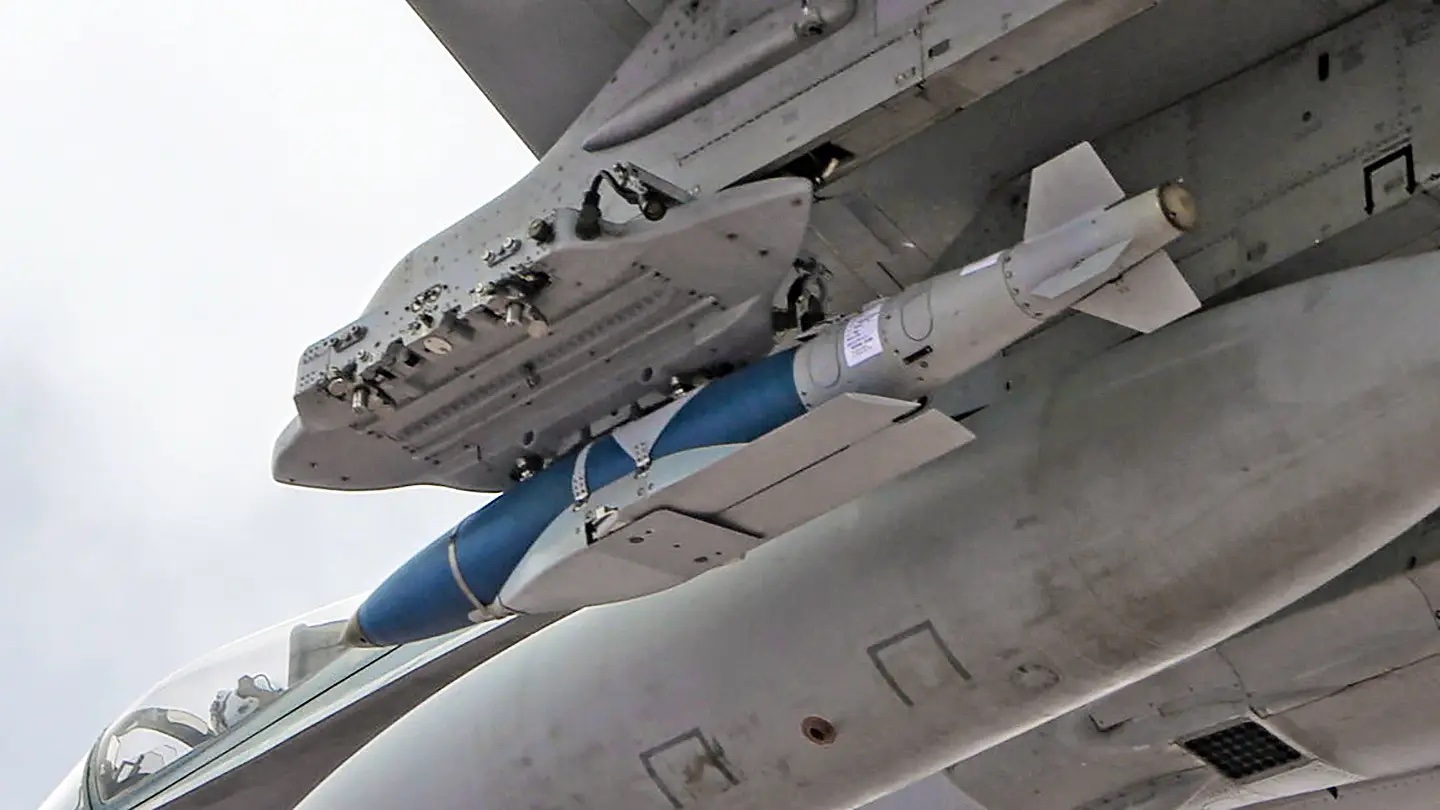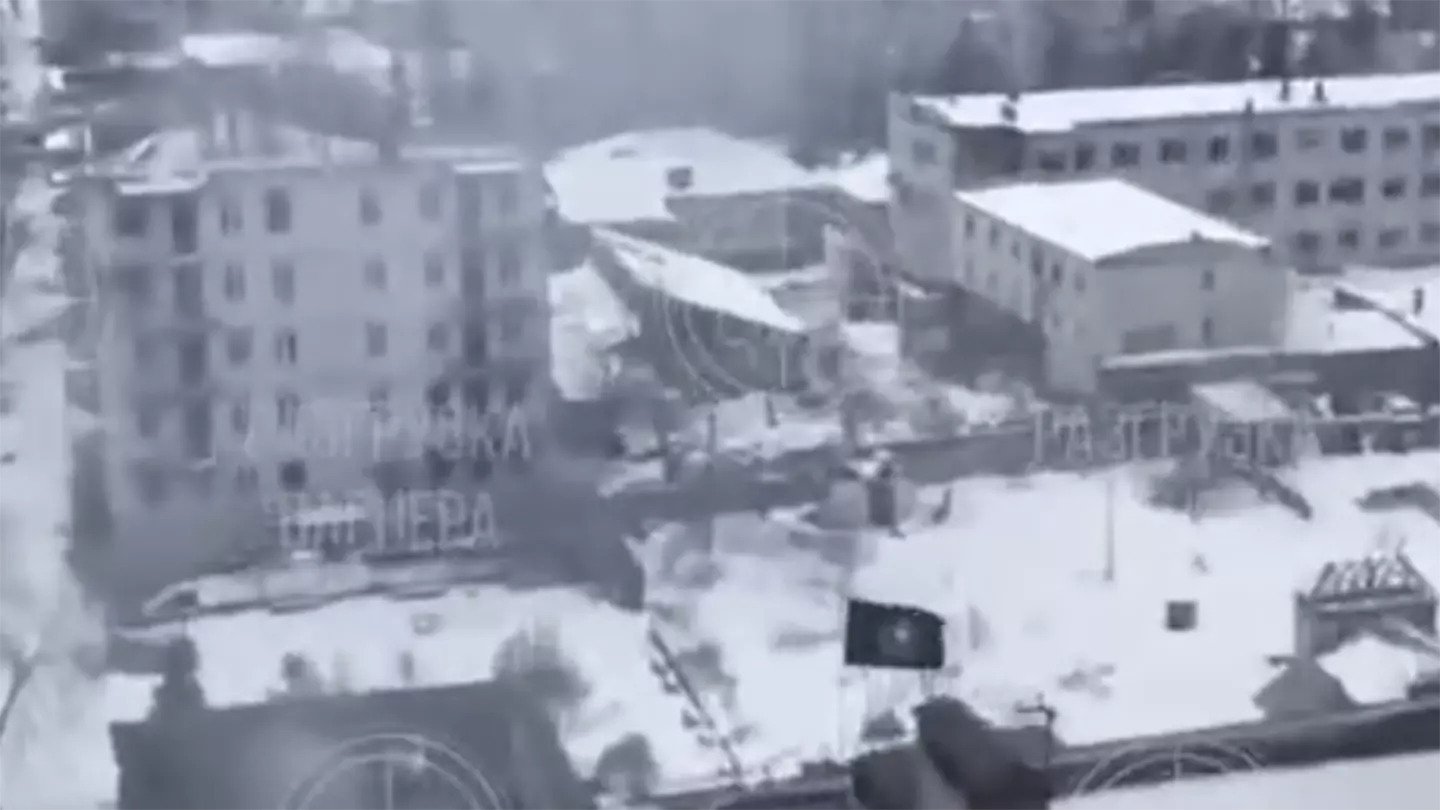The Wagner mercenaries have planted its black flag atop a highrise in the embattled city of Bakhmut.
“Winter, snow-covered Bakhmut,” Wagner’s head honcho Yevgeny Prigozhin posted on his Telegram channel Friday. “It snowed for the first time in a long time. On the occupied positions, the black flag of the ‘musicians’ develops.”
The post included video showing the Wagner group’s black flag waving atop a high-rise building in the battered city now covered by snow.
Online OSINT observers provided geolocated confirmation that the flag is where Prigozhin claimed.
The tactical and strategic significance of Wagner troops being in the city center is unclear. There is no indication that those troops have entered the central city in large numbers or were backed by armor.
Russian progress in Bakhmut has been limited at best as of late. By some accounts, they have gained mere blocks of the city and at a very high cost.
The seven-month-old battle, the longest in the all-out war, is still raging. And clearly, one of the Ukrainian defender’s greatest advantages has been the difficulty of assaulting a city where buildings offer shelter as well as firing and observation points. Combat in urban environments is notoriously challenging and hazardous.
The Wagner group, which has been doing a large amount of the fighting there for Russia, has taken extreme losses, up to 500 or more troops a day, Ukrainian officials claim. The Institute for the Study of War estimates that Wagner has suffered tens of thousands of casualties trying to take the city. They currently have upwards of 36,000 troops fighting in Bakhmut, Army Gen. Mark Milley, chairman of the Joint Chiefs of Staff, testified before the House Armed Services Committee on Wednesday.

The Ukrainian Defense Ministry (MoD) on Friday offered a terse description of the situation there in its daily operational roundup.
“In the direction of Bakhmut, the enemy does not stop storming the city of Bakhmut, trying to take it under complete control,” the MoD stated on its Telegram channel. “During the day, the enemy shelled the settlements of Orihovo-Vasylivka, Novomarkove, Hryhorivka, Bakhmut, Ivanovske, Ozaryanivka and Mayorsk of the Donetsk region.”
But in an interview with The New York Times published Thursday, a Ukrainian commander on the ground suggested that the assault on Bakhmut was on its last legs.
“The enemy exhausted all its reserves,” the commander, Col. Yevhen Mezhevikin, 40, told the newspaper on Tuesday.
The Russian assaults have slowed, Mezhevikin told the Times, and the imminent threat of encirclement has been thwarted.
“The density of assaults dropped by several times,” he said. “Before, they could assault in all directions simultaneously and in groups of not less than 20, 30 or 40 people, but gradually it is dying down.”
On Thursday, Deputy Defense Minister Hanna Malyar said on her Telegram channel there are days when Ukrainian troops kill ten times as many Russian troops as they lose.
“Unfortunately, losses are an inevitable consequence of war,” she wrote. “One of the main tasks of the warring party is to destroy the enemy’s physical strength. But the losses of the enemy are many times greater. This despite the fact that they have an advantage in the number of personnel and weapons.”
“We have days in the East where the kill ratio is as high as 1 to 10,” she said. “This is, of course, not every day, and the average coefficient is lower, but less nonetheless.”
Regardless of the military significance of the Wagner flag appearing in central Bakhmut – it could have been placed by a small team that infiltrated the area – it no doubt has a psychological impact.
In an interview published by The Associated Press on Wednesday, Ukrainian President Volodymyr Zelensky predicted that there would be fallout – domestically and internationally – from losing Bakhmut.
“Our society will feel tired,” he said. “Our society will push me to have compromise with them.”
Before we dive into the latest updates from Ukraine, The War Zone readers can get caught up on our previous rolling coverage here.
The Latest
Ukrainian air defenders claimed to have destroyed nine out of 10 Shahed drones that attacked Thursday night into Friday morning, according to the Ukrainian Air Force Telegram channel.
“From 9:10 p.m. on March 30 to 1:30 a.m. on March 31, the enemy attacked Ukraine with ‘Shahed-136/131’ attack drones, and up to five other aerial targets, presumably balloons, were also recorded in the sky.”
The Russians attacked from the north, in the Bryansk Oblast of Russia, with the drones traveling through Ukraine’s Sumy and Chernihiv regions.
One drone was destroyed by the air defense unit of the Ground Forces and eight by the Air Force anti-aircraft missile units and mobile fire groups, the Ukrainian Air Force said.
On the first anniversary of the liberation of Bucha – a Kyiv suburb that became synonymous with Russian brutality – Zelensky hosted the first Bucha Summit Faces of Justice, “dedicated to discussing the mechanisms of bringing the aggressor state to full accountability for crimes against the Ukrainian people and humanity.”
Zelensky said that during the occupation of the Bucha district of the Kyiv region alone last year, “Russian occupiers committed more than 9,000 war crimes, killed more than 1,400 civilians [including] 637 in Bucha” proper.
“We must do everything to make Bucha a symbol of justice,” Zelensky said. “Justice for Ukraine, for Europe, for the whole world. That every Russian murderer, executioner and terrorist answer for every crime against our people, against humanity as such. Everything that happened in Bucha, the Russian army carries wherever it goes.”

It looks like more U.S. military aid will be heading to Ukraine.
A new $2.6 billion package “that could include air surveillance radars, anti-tank rockets and fuel trucks for Ukraine’s fight against Russia is expected to be announced as soon as Monday,” Reuters reported Friday, citing three U.S. officials. Fuel trucks have become one of Ukraine’s key weapons in withstanding relentless missile attacks on its energy infrastructure. You can read all about how they have played such a critical role in this previous report.
The package is expected to include “precision aerial munitions, bridging equipment Ukraine would use to assault Russian positions, recovery vehicles to help disabled heavy equipment like tanks and additional rounds for [National Advanced Surface-to-Air Missile System] (NASAMS) air defenses that the U.S. and allies have given to Kyiv,” Reuters reported, without specifying what kind of precision aerial munitions. But the U.S. has previously donated Joint Direct Attack Munition, or JDAM, air-launched precision-guided weapons to Ukraine. Today, Ukraine Air Force spokesman Col. Yuri Ignat announced they have been used in combat. You can read our full report on the confirmed JDAM use here.

The package, expected to be finalized over this weekend, could also include “half a dozen types of munitions, including tank munitions,” Reuters reported, citing the officials speaking on condition of anonymity who added that “the dollar amount and specific equipment in the package could change.”
The aid was comprised of “$2.1 billion in weapons aid coming from Ukraine Security Assistance Initiative (USAI) funding that allows President Joe Biden’s administration to buy weapons from industry rather than from U.S. weapons stocks,” according to Reuters.
The remaining $500 million, “mainly comprised of munitions to help Kyiv push a spring offensive against Russia’s invasion, was expected to come from Presidential Drawdown Authority funds, which allow the president to take from current U.S. stocks in an emergency.”
The U.S. has now pledged more than $30 billion worth of security assistance to Ukraine since the invasion.
A Russian military officer faces up to 10 years in prison for failing to stop what is being called a deadly Ukrainian attack on Belgorod in Russia early in the war, according to the Telegram channel of the Russian Baza news outlet.
It is the first such case in modern Russian history, according to Baza.
The case against the officer, known only as “Dmitry D.” was opened last spring.
“According to the investigation, he was on combat duty and, having every opportunity, failed to prevent the Ukrainian attack with the help of the air defense system. It led to death and injury among the military, and part of the equipment was destroyed.”
Baza did not specify when the attack took place, but this video below shows one such attack around that time period.
The Belgorod region has been a frequent target of Ukraine. Since April 2022, there have been multiple reports of Ukraine’s armed forces striking at targets in Belgorod, which lies just on the opposite side of the country’s northeastern border.
As a result of the incident Dmitry D. was involved in, prosecutors decided to charge him “under Part 2 of Article 340 of the Criminal Code of the Russian Federation (Violation of the rules for carrying out combat duty, which entailed grave consequences).”
Concurrently, another case was opened against Dmitry D. “for abuse of power, which provides for another three to 10 years,” according to Baza.
“According to military investigators, the officer, along with his own mistakes, also poorly organized the work of his unit.”
Dmitry D. did not admit his guilt “and is now under arrest in St. Petersburg.”

The Ukraine Weapons Tracker OSINT group reported the first confirmed use by Ukraine of the Norwegian-donated Hellfire Shore Defense System after one of the Hellfire missiles used by the system was found by Russian forces in the Kinburn Spit in Kherson Oblast. The system is similar to the Swedish RBS-17 coastal defense missile, which first appeared on the battlefield in October.
If you ever wanted to see a First Person Video (FPV) drone fly into a tank and blow it up, then check out this video below of a Ukrainian FPV doing just that to a Russian tank.
And if you want to see how a Javelin anti-tank missile works, check out this video below, taking special note of the trajectory of the projectile.
There was a very close call for this Ukrainian tank crew, as you can see in this video below showing some intense fighting near Russian trenches.
A Russian tank also had its day. Its crew was seen in this video below capturing Ukrainian troops near the forests of Kreminna in Luhansk Oblast.
The U.S.-supplied MK-19 grenade launcher is a fearsome weapon, enabling the operator to rapidly fire off 40 mm grenades at an enemy. You can see this Georgian member of the Ukrainian International Legion do just that in this video below.
This Ukrainian soldier may be the luckiest man on the battlefield.
“The other day, during the fighting in one of the mission areas, an enemy 30-mm shell from an infantry fighting vehicle hit a soldier, passing through the back and getting stuck in the soldier’s stomach,” Ukraine’s Military Media Center reported Friday on its Telegram channel.
“Military medics of the 66th OMBr, who work tirelessly every day and are the best surgeons and specialists, performed a successful operation and saved the defender’s life. The serviceman has already returned to the formation and, together with his combat comrades, performs combat tasks at the positions!”
And you thought you had a tough day.
And finally, these Ukrainian troops developed a rather rude greeting for the Russian invaders.
That’s it for now. We’ll update this story when there’s more news to report about Ukraine.
Contact the author: howard@thewarzone.com
